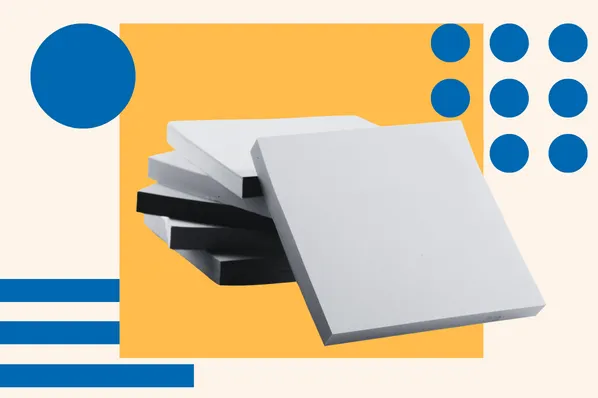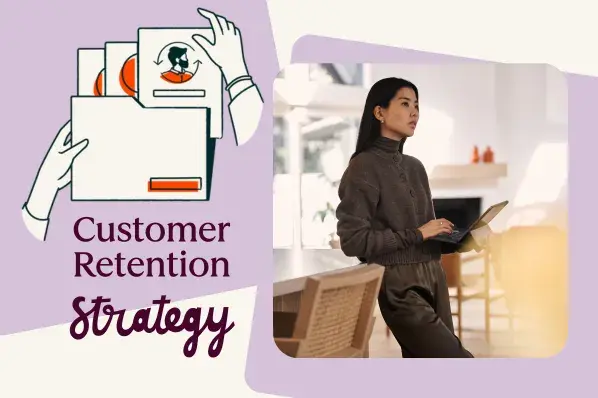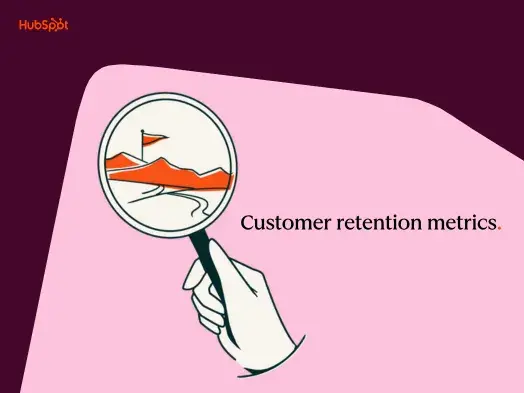In this post, we'll review what customer stickiness is, how to increase it, and how to turn sticky customers into loyal customers.
Table of Contents
- What is customer stickiness?
- How to Increase Customer Stickiness
- How to Turn Sticky Customers Into Loyal Customers
What is customer stickiness?
Customer stickiness is a metric similar to retention and loyalty, though not exactly the same.
Customer stickiness is instead focused on measuring how likely a customer is to continue purchasing your product or service in a competitive landscape.
Getting a customer to make a second purchase will majorly impact your revenue and ROI. On average, repeat customers spend 67% more than new customers.
Every time a buyer continues to purchase from you, the likelihood that they'll buy from you again increases. Then, your customer lifetime value will increase, and your customers will stick to your brand for years. Score.

Think about your value proposition. Why is your product better than your competitors'? What value do you bring? Is it price, convenience, product quality, or customer service?
Whatever it is, to increase customer stickiness, you have to know why customers continuously purchase your product and the value they get from your company — but we'll dive into that more below.
To calculate customer stickiness, just divide repeat customers by all customers and multiply by 100.
Let's say you have 1,000 new subscribers every month, and 150 of them are repeat purchases. That would mean your customer stickiness was at 15%.
Okay, so why does this matter?
Why Customer Stickiness Matters
Customer stickiness is important because sticky customers are more likely to become loyal customers with whom you can develop and strengthen your customer relationship.
Additionally, customer stickiness positively impacts your customer service metrics, including churn rate, customer lifetime value, customer retention, and customer loyalty or referrals.
More sticky customers will lead to more referrals and better ratings or reviews, leading to more sales and higher revenue.
With increased customer loyalty, brand advocates are more likely to spread positive word-of-mouth, which is vital for your company.
You'll notice we're talking about customer stickiness and customer loyalty as different metrics. That's because they aren't the same thing.
Let's dive into the differences below.
Customer Stickiness vs. Customer Loyalty
Customer stickiness measures how likely a customer is to make a repeat purchase from you. It's a transactional metric, not focused on your brand but on your product or service.
On the other hand, customer loyalty references customers who love your product so much that they become brand advocates and don't consider other alternatives.
Customer stickiness occurs because of the value your product or service provides.
But customer loyalty requires a deeper relationship. It's when a customer has an emotional bond with your brand and trusts your company so much that if a competitor offers lower prices, they still won't consider switching.
Customer stickiness is like a stepping stone for your metrics. Once a customer is sticky, you can retain them, they are less likely to churn, and their likelihood to build loyalty with you increases.
Now, let's talk about how you can build and increase customer stickiness.
How to Increase Customer Stickiness

1. Offer high-touch onboarding.
Customer stickiness is about your value proposition, right? But sometimes, certain customers can use your product or service differently.
Your value proposition can be relative depending on the type of customer or the product or service they purchased.
If you offer high-touch onboarding, your account managers will be able to immediately introduce your product or service's unique value for a customer.
That means you'll want to offer high-touch onboarding that is developed based on the customer journey.
What did that customer say was their biggest pain point? Why did they choose to purchase from you? What are they most looking forward to using?
Your account managers will need this information to develop a truly high-touch, high-end experience.
This type of onboarding will help users get value from you immediately. When they see your value, they'll be more likely to purchase again (that's stickiness!), whether that's a product, subscription, or contract renewal.
2. Provide repeated value.
Another way to promote repeated purchases is to provide value continuously. This means that you have product announcements regularly.
You can introduce new features and encourage users to purchase again because your product gets better and better.
Value = stickiness.
3. Know your value proposition.
The main way to increase your customer stickiness is to know what your value proposition is in the first place.
Many companies post this in a mission statement or values page, so check out your company's to see what it is. If it's not posted publicly, ask your manager. Usually, your company's value proposition is taught to you in training.
Everyone on your team needs to know your value proposition to make your messaging consistent and persuasive. And, of course, it will help your customer success team provide that value to their customers daily.
4. Assess the customer journey and experience regularly.
A customer makes a repeat purchase because they had a good customer experience, right? Right. Many companies discuss the customer journey and customer experience at the beginning of the business.
But this needs to be regularly assessed. Is the customer journey you hoped to provide actually what a customer goes through? What are the customer touchpoints, and how can you optimize the experience?
By getting in touch with your customer journey and customer experience, you'll see the value you provide for your customers and can continue providing that value.
You'll need to know why customers are churning (if they are) and focus on improving those pain points by providing — you guessed it — value.
5. Conduct user research.
Similar to the point above, you need to know why customers stay loyal to you.
Why and how did a customer go from a one-time purchase to a repeated purchase to a brand advocate? To find this out, conduct user research.
Find out the value you provide directly from the customers themselves. You'll want to survey and interview customers, asking them what made them realize your product was right for them and what features they can't live without.
Then, you can replicate the experience and create true customer stickiness.
6. Add customer stickiness to your regularly reported metrics.
The only way to know if you're increasing your customer stickiness is to measure it. I know that sounds obvious, but customer stickiness isn't always a metric that success teams track.
To improve your stickiness, you need to know what your baseline is and then focus on implementing strategies specifically meant to increase value and repeat purchases.
7. Up- and cross-sell similar products or services.
A repeated purchase indicates that a customer is happy with your product or service. And happy customers are the ones you want to upsell and cross-sell whenever you get the chance.
This can come from your account managers, your success team, or even email blasts sent out to repeat buyers to encourage them to buy a similar product or service.
8. Send personalized email content.
Speaking of email blasts, you can increase customer stickiness by sending personalized email content in the form of reminder emails.
These emails remind customers that it's time to renew their subscription or purchase your product again.
Encourage your customers to buy from you, then encourage them to buy again and again. After a customer buys your product or service, you can send promotional emails showing more products they might like.
Once you've increased customer stickiness — i.e., created more repeat customers — how can you turn those sticky customers into loyal customers/brand advocates?
Let's explore.
How to Turn Sticky Customers Into Loyal Customers
Customer loyalty is driven by similar strategies to customer stickiness. You'll still need to provide value and build a great customer experience to encourage a sticky customer to become loyal.

Below are some more tips to dive into.
1. Build a customer loyalty program.
A customer loyalty program will encourage your sticky customers to join a loyalty program where they receive benefits or perks for continuing to purchase from your company.
These perks include early access to new products or events, exclusive merch, exclusive content, awards, a free service, etc.
For example, my local massage parlor offers a loyalty program where after 10 massages, you get the next one free. At my grocery store, the program means I get discounted items.
And guess what? I'm loyal to my massage parlor and grocery store. I don't usually, if ever, try a new or different one because of the benefits of continuing to purchase from the same company.
In fact, 68% of loyal customers will join a loyalty program if offered, and the rewards and unique offers are additional incentives for them to continue their purchases.
These customers are also likely to spend more money with you and become brand advocates.
What we like: Incentivizes customers to continue purchasing from you, directly increasing your customer stickiness and improving the customer experience.
2. Implement customer surveys.
One way to turn a sticky customer into a loyal customer is to send out surveys and ask your customers about their experience.
Surveys with both closed and open-ended questions give customers the chance to tell you why they've repeatedly purchased from you, what would get them to join a loyalty program, etc.
You can also ask how to improve their customer experience and increase your value. When you increase your value to a customer, they're more likely to become loyal.
Pro tip: Regularly send out customer success surveys to measure your customer satisfaction.
3. Track customer metrics such as NPS.
To turn a sticky customer into a loyal customer, you need to know your NPS (net promoter score), CSAT (customer satisfaction), and churn rate.
By tracking these metrics, you'll learn how likely your customers are to churn, how satisfied they are with your product or service, and how likely they are to recommend your business to a friend.
All of these metrics work in tandem. A sticky customer becomes loyal because they're satisfied with their experience, they'd recommend you to a friend, and they want to keep building their relationship with your brand.
Pro tip: Create an Excel or Google sheet tracking your customer success metrics so you can see them all in one place.
4. Invest in customer success.
I hate to say it, but this is the most important way you can turn a sticky customer into a loyal customer.
You need to put your money where your mouth is and include conducting surveys, user research, and high-touch onboarding into your budget plans.
You'll need to invest in software, team members (maybe even whole teams dedicated to customer research and interviews), loyalty program incentives, and resources for your employees.
You'll also need to budget for ongoing product training and support for your customer success team to share with their customers. Infrastructure and support are vitally important for your team to be able to produce the metrics you want.
What we like: Investing in customer success shows your dedication to customer loyalty. Your customers can tell — they're getting a high-class customer experience because of it.
5. Continue providing amazing service.
Last but not least, to turn a sticky customer into a loyal customer, you just need to provide an excellent customer experience.
I know it's easier said than done, but focusing on providing great service and support will turn sticky customers into loyal customers quickly.
Pro tip: Regularly review your customer service reps and stay in touch with the type of service your customers receive.
Sticky Customers
Ultimately, customer stickiness is the metric that helps you track repeat buyers. It will help you understand what value you bring to your customers, how you can build customer loyalty, and how to increase your brand advocates.
Customer Retention
.png?width=112&height=112&name=Image%20Hackathon%20%E2%80%93%20Square%20(30).png)


-2.png)
![7 Customer Acquisition Challenges You Might Face This Year [New Data]](https://53.fs1.hubspotusercontent-na1.net/hubfs/53/customer%20acquisition%20%20(1).webp)




![7 Secrets for Getting Repeat Customers That Stick Around [Consumer Data]](https://53.fs1.hubspotusercontent-na1.net/hubfs/53/repeat-customers.jpg)


